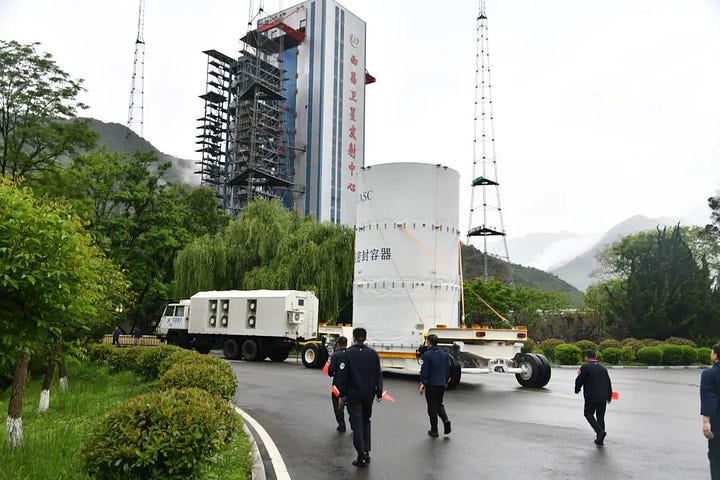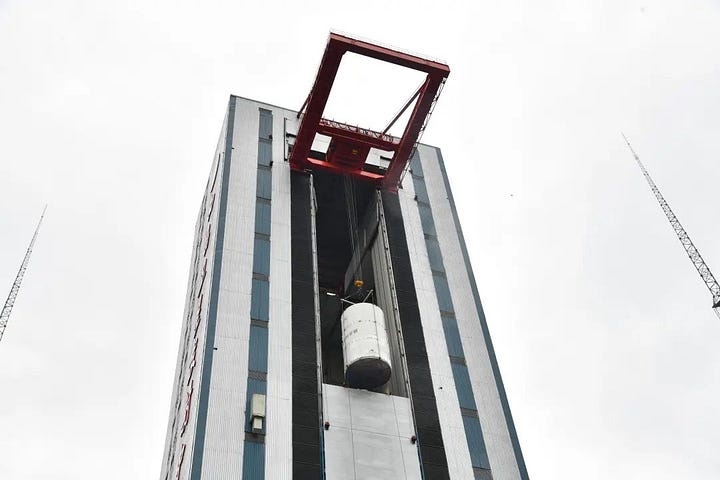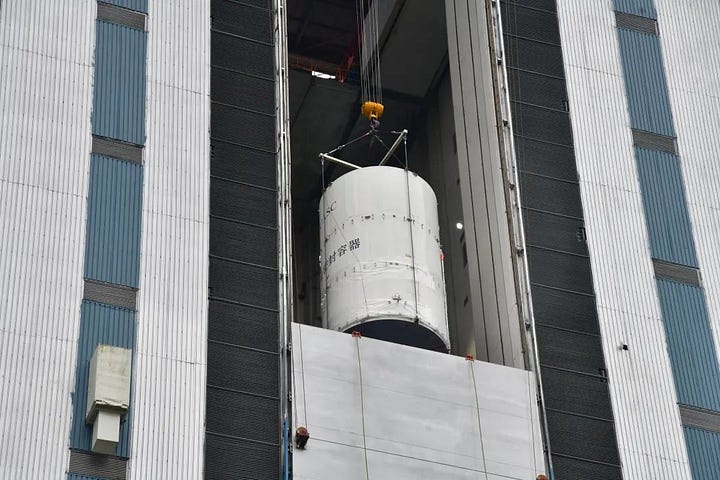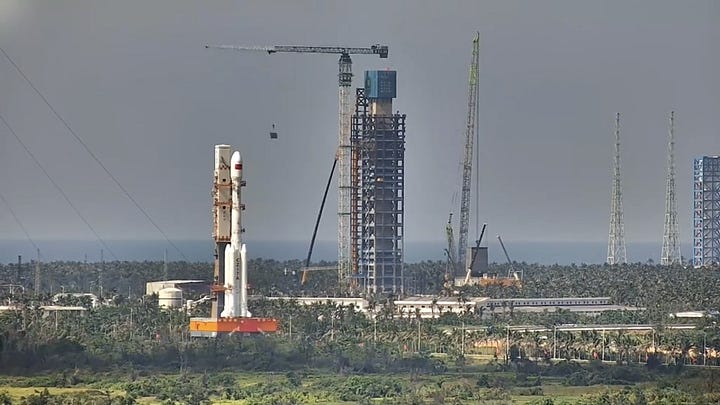Tianwen-2 Probe Near Launch, New Life on Tiangong
Meanwhile, BeiDou generates billions and the Long March 10 inches forward.
Following the May Day holidays, China’s space sector is back in full swing with progress on a deep space probe, reusable rockets, and launch infrastructure in Wenchang. The past two weeks were busy but diverse across the sector, ahead of the halfway mark of the year.
Tianwen-2 moved to Long March 3B/E




On May 18th, the China Academy of Space Technology (中国空间技术研究院) shared that the Tianwen-2 probe, which will collect samples from a near-Earth asteroid, was moved to Launch Complex 2 at the Xichang Satellite Launch Center. This follows completion of testing and fueling of the spacecraft over the past few weeks.
Tianwen-2 has been at Xichang since late February for launch preparations. Hazard notices indicate that liftoff for Tianwen-2 atop of the Long March 3B/E could occur as soon as May 28th.
Following launch the spacecraft will begin its long journey out to asteroid 2016HO3, arriving sometime in 2027. While flying alongside the asteroid Tianwen-2 will search for a suitable sampling site before collecting between 200 and 1,000 grams of samples via touch-and-go as well as anchor-and-attach methods. Once these samples are secured in a sample container, the spacecraft will head back toward Earth and drop off the samples around 2029 during a flyby.
After the sample canister is released for retrieval by teams back on Earth, Tianwen-2 will begin its extended mission to asteroid 311P out in the asteroid belt between Mars and Jupiter. Throughout the early 2030s, Tianwen-2 is planned to thoroughly study 311P whilst doubling as a test of China’s deep space communications infrastructure ahead of the Tianwen-4 mission to Jupiter.
If the mission is successful, China will be the third nation to collect samples from an asteroid, after the United States and Japan. With more samples on Earth, greater scientific breakthroughs related to the birth and creation of the solar system can be made.
New microbe species discovered on Tiangong
Recently, scientists have published their findings of a new species of microbe, called Niallia tiangongensis, discovered aboard the Tiangong Space Station. This new species is said to have been initially found during the Shenzhou-15 mission in 2023.
Researchers believe that Niallia tiangongensis has become well-suited to surviving the complex environment of microgravity along with developing a stronger oxidative stress response, allowing it to be more resilient than comparative strains on Earth. Research into Niallia tiangongensis is still underway, but early analysis suggests that the microbe may be able to effectively break down some organic compounds, which would be useful for processing waste or recycling in orbit.
Long March 10 infrastructure grows


Since emerging above the tree line in January, the infrastructure for the Long March 10 Moon rocket has continued to grow over the past few months at the Wenchang Space Launch Site.
Launch Complex 301’s launch support tower, for the Long March 10, has quickly come to dominate the Wenchang skyline, recently having had its central structural core reach its planned maximum height. Additional structures that will serve as the attachment points for various service platforms have followed the central core skyward. With the recent rollout of the Long March 7A Y15 vehicle, expected to launch on May 20th, the scale of the launch support tower is obvious.
Next to the launch support tower at Launch Complex 301, the flame trench to redirect the heat and thrust generated at liftoff is having reinforced concrete set. One of the Long March 10’s mobile launch platforms is also under construction ontop of part of the rail system that will connect the launch pad to two assembly buildings.
A few miles away at the vehicle assembly site, two vehicle assembly buildings are sprouting up in support of the Long March 10. At the moment, the two buildings are under half of their expected height.
No timeline for completion of the Long March 10’s launch infrastructure at Wenchang has been released, but the end of 2025 is rumoured to be a target date.
140-ton thrust methane engine fired up
The China Aerospace Science and Technology Corporation (中国航天科技集团有限公司) stated on May 12th that it had fired up a liquid methane and liquid oxygen engine capable of generating 140 tons of thrust, a few weeks earlier. This engine, while not naming the launch vehicle, is planned to propel reusable rockets.
According to the China Aerospace Science and Technology Corporation, the engine performed a joint demonstration of all systems only seven months after individual component testing began, while designs were finalized. This short testing timeframe was said to be thanks to integrated product team collaboration and 3D printing technologies.
Citing the success of developing the 140-ton thrust liquid methane and liquid oxygen engine, along with a 90-ton thrust version fired up last December, teams are hoping to fire up another engine using the same propellants while generating 200 tons of thrust in a few months.
Cosmoleap fires up attitude thrusters
Cosmoleap shared on May 19th that it had performed its latest test of its 100-newton and 300-newton attitude control thrusters for its Leap-1 (跃迁一号) launch vehicle. These thrusters will help control both the first-stage, while heading toward landing, and the second-stage, while in space, during unpowered flight.
The company stated that the recent test of a handful of 100-newton and 300-newton thrusters demonstrated successful coordination of their firings, as would be needed during flight. For the test, a storable propellant was sent to an undisclosed number of thrusters from helium-pressurized tanks inside a mock-up avionics section of the rocket. Firings of the engines were said to have shown pitch, roll, yaw, and propellant settling maneuvers.
Cosmoleap’s thrusters used for the test are believed to have first fired up in January. Cosmoleap is currently pursuing an aggressive launch timeline with a first flight hoped for before the year’s end.
Wuhan opens UN-SPIDER office
On May 7th, it was reported that the United Nations Office for Outer Space Affairs Director, Aarti Holla-Maini, led a delegation to Wuhan University (武汉大学) to sign a memorandum of understanding with the university’s president, Zhang Pingwen (张平文), to open the China regional support office of the United Nations Platform for Space-based Information for Disaster Management and Emergency Response, shortened to UN-SPIDER. This new office is expected to serve as a regional hub for cooperation on technology applications and space law, to maintain the peaceful use of outer space and to solve critical issues faced on Earth.
According to Zhang Pingwen, the new office recognizes the university’s scientific research capabilities and establishes a platform for deeper engagement in global disaster governance, allowing Wuhan to contribute its expertise to address global challenges. Aarti Holla-Maini added that the new office will strengthen the UN-SPIDER's global network, while praising the university’s contributions to space-based disaster mitigation efforts.
Chinese regulations for D2D services issued
The Global Times reported on May 1st that the Cyberspace Administration of China (国家互联网信息办公室), among other government departments, has jointly issued new regulations to govern devices that directly connect to satellites in orbit. This service is called direct-to-device, abbreviated as D2D, in the West.
This new regulation, called Regulations on the Management of Terminal Equipment Directly Connected to Satellite Services (终端设备直连卫星服务管理规定), is expected to support the research, development, and integration of direct-to-device technologies, standardization, application promotion, lawful data utilization, and international cooperation to foster the healthy growth of the space satellite service industry while ensuring public and national security interests. With the regulation, any enterprise providing direct-to-device services from satellites must obtain the necessary licenses and approvals, while meeting national standards, from regulatory bodies before offering services to customers.
BeiDou services valued at 576 billion Yuan
China Daily is reporting, citing a white paper from the Global Navigation Satellite System and Location-Based Services Association of China (中国卫星导航与位置服务协会), that the value of services provided by the BeiDou satellite network reached around 576 billion Yuan (approximately 80 billion United States Dollars) by the end of 2024, an increase of 7.39 percent. This valuation is from the economic activity stimulated by BeiDou services.
Additionally, it was stated that 288 million mobile phones in China had BeiDou services enabled, making up a small part of the 2 billion devices using the satellite network’s services. With that many devices being served, over one trillion location services were being performed daily in China for intelligent connected vehicles across fifty cities.
In addition to generating economic activity, it was reported that approximately twenty thousand enterprises building on the BeiDou network employ almost one million people.


